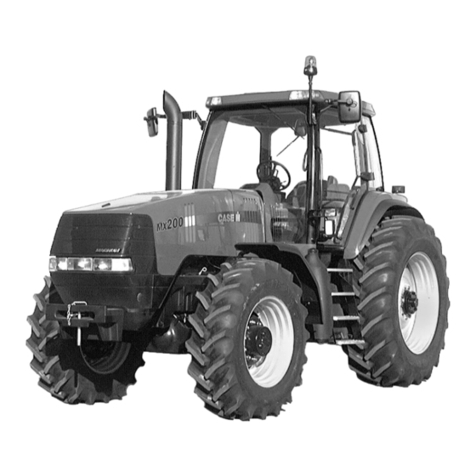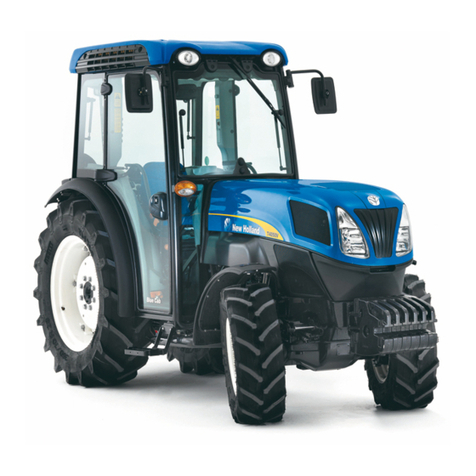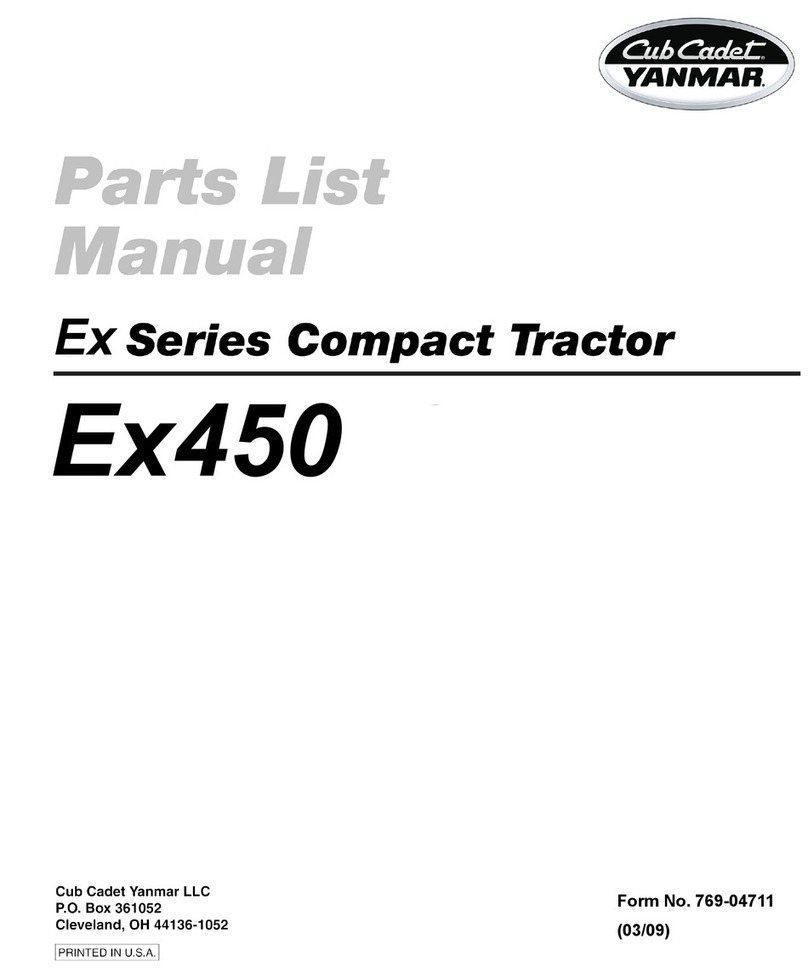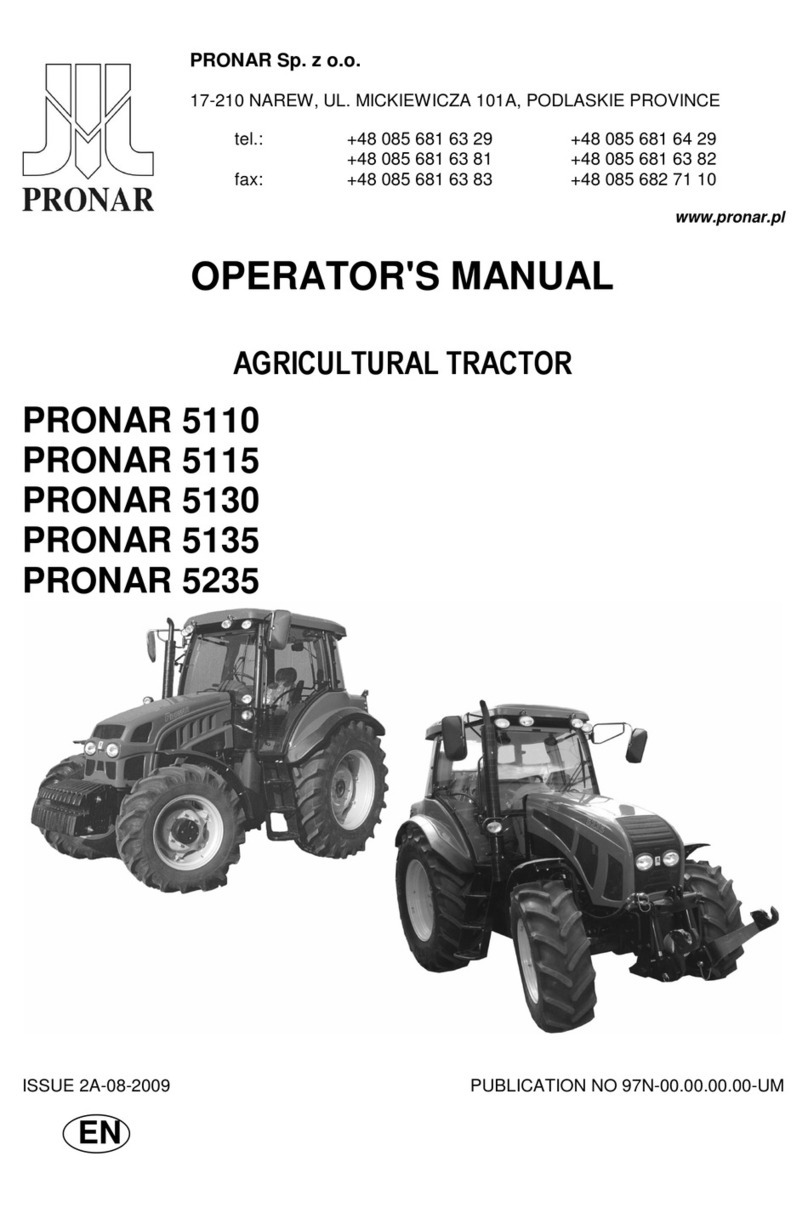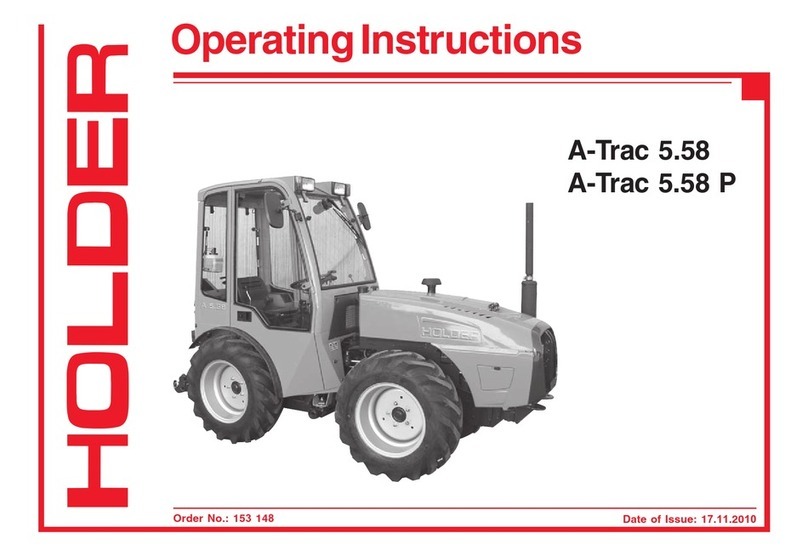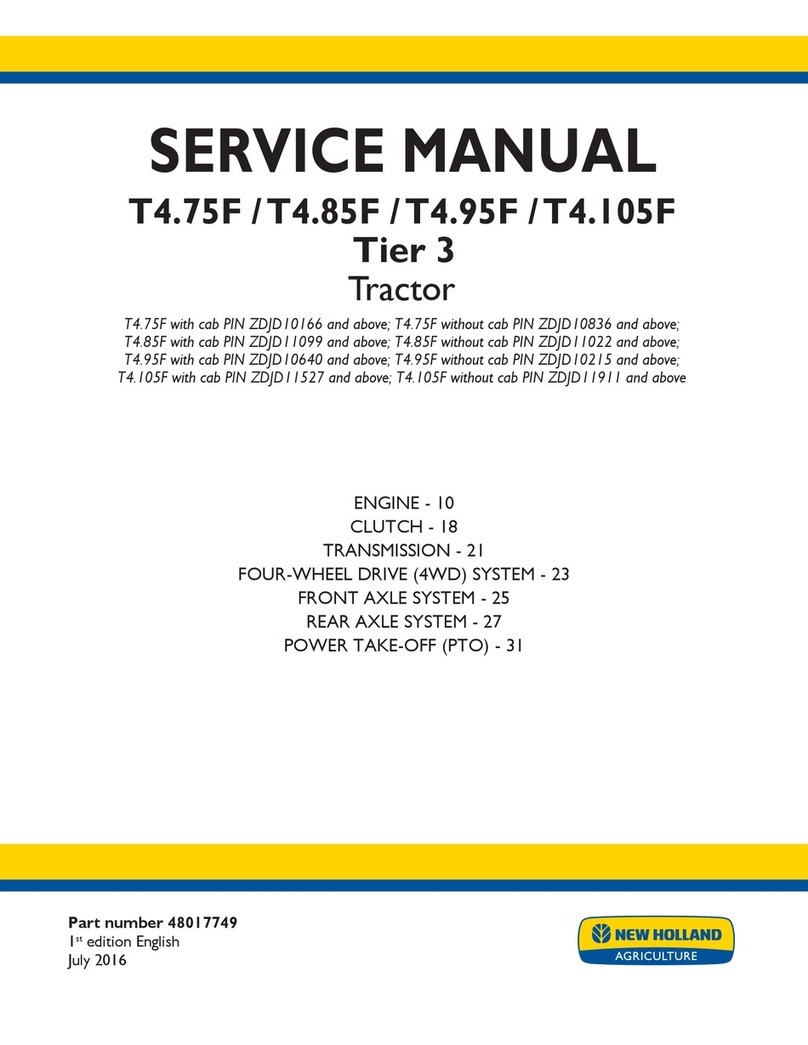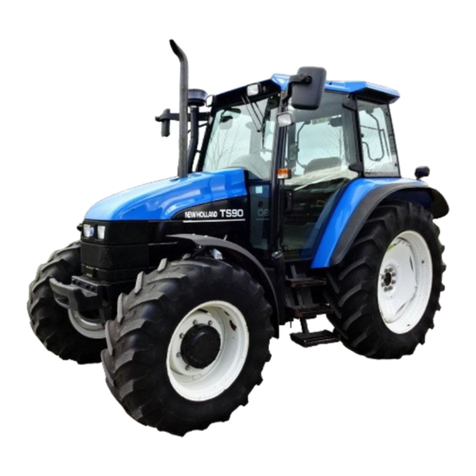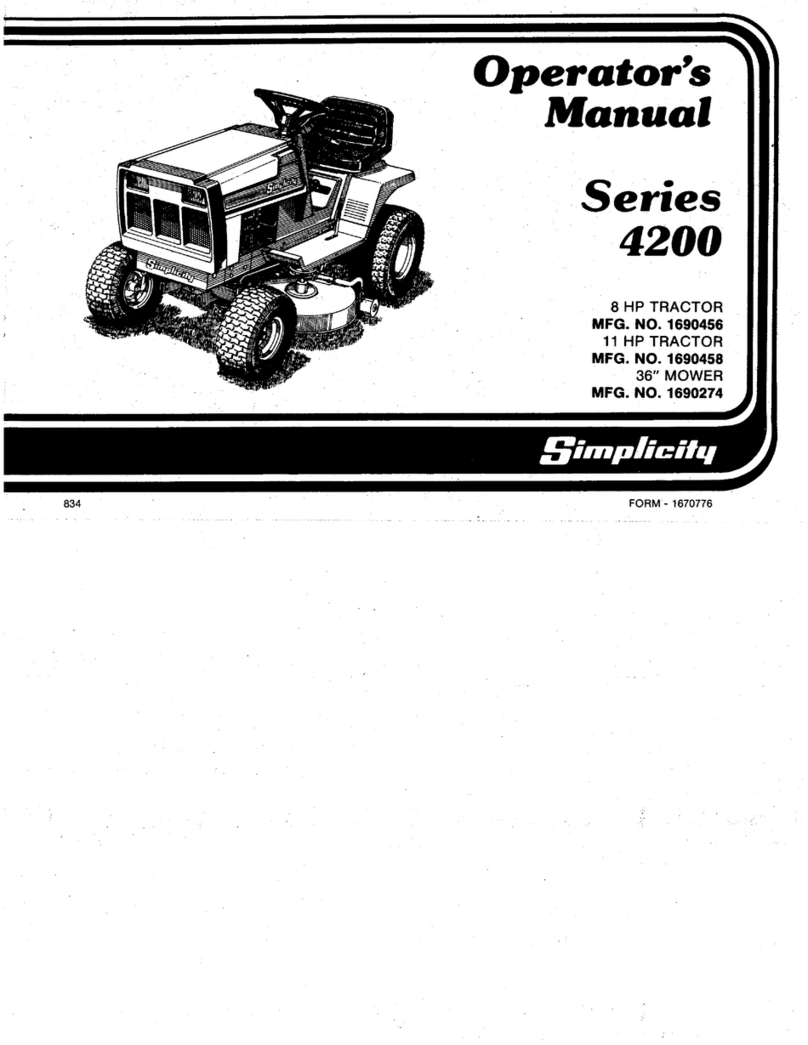Koppl Easy 500 Operation instructions

MOTORG ERÄTEFABR I K
94163 ENTSCHENREUTH
(0 99 07) 89 10-0 - Fax (0 99 07) 10 4
Internet: http://www.koeppl.com
email: info@koeppl.com
Type E500 = Easy 500
Retain for future reference!
Rev. date / edition
11/1/2010 – No. 01-2010
Translation of the original manual
for
2-wheel tractor
The basis for working with the 2-
wheel tractor is that you read, understand and follow this
operating manual and that for the attachments as well as the engine manufacturer’s operating
manual. You may not commence with the operation before having done so.
It is forbidden to start work without observing this manual!
Type Easy 500 = E500

Page 2
Version 01-2010
Table of contents
E500
Table of contents
Table of contents .......................................................................................................................... 2
Foreword ...................................................................................................................................... 3
Appropriate use ............................................................................................................................. 4
General safety instructions ............................................................................................................. 5
1.
Possible hazards in dealin with the 2-wheel tractor ........................................................................................ 5
2.
Explanation of the safety symbols used ..................................................................................................................... 5
3.
Hazards due to accessories ...................................................................................................................................... 6
4.
Noise / vibration values ............................................................................................................................................ 7
5.
Sources of dan er ................................................................................................................................................... 7
6.
Li htin devices on sin le-axle tractors, .................................................................................................................... 8
7.
Operator position ..................................................................................................................................................... 9
8.
Requirements for the operatin personnel ................................................................................................................. 9
9.
Personal protective equipment ............................................................................................................................... 10
10.
Safety measures at the place of work ..................................................................................................................... 10
11.
Protective devices .................................................................................................................................................. 11
12.
Leavin the 2-wheel tractor .................................................................................................................................... 12
13.
Safety of attached devices ..................................................................................................................................... 12
14.
General safety instructions ..................................................................................................................................... 13
15.
Brakes .................................................................................................................................................................. 13
16.
En ine .................................................................................................................................................................. 13
17.
Tyres, screwed connections .................................................................................................................................... 13
Transport .....................................................................................................................................14
1.
Tractor size / machine dimensions .......................................................................................................................... 14
2.
Technical data ....................................................................................................................................................... 15
3.
Tyres .................................................................................................................................................................... 15
Operation ....................................................................................................................................16
1.
Commissionin ...................................................................................................................................................... 16
2.
Startin ................................................................................................................................................................. 16
3.
Shaft hei ht adjustment ......................................................................................................................................... 17
4.
Clutch ................................................................................................................................................................... 17
5.
Gear shift – forward/reverse ear ........................................................................................................................... 18
6.
Shiftin speed ....................................................................................................................................................... 19
7.
Power take-off en a ement/disen a ement ............................................................................................................ 20
8.
En ine .................................................................................................................................................................. 20
9.
Throttle lever ........................................................................................................................................................ 21
10.
Device connection ................................................................................................................................................. 21
Troubleshootin ...........................................................................................................................22
1.
Faults and their remedy ......................................................................................................................................... 22
Maintenance ................................................................................................................................24
1.
Clutch ................................................................................................................................................................... 24
2.
Gearbox ................................................................................................................................................................ 25
3.
Drivin wheels ....................................................................................................................................................... 26
4.
Attached devices ................................................................................................................................................... 27
5.
General ................................................................................................................................................................. 27
6.
Safekeepin and stora e ........................................................................................................................................ 27
7.
Maintenance schedule ............................................................................................................................................ 28
Appendix .....................................................................................................................................29
1.
Lubricants / adhesives ........................................................................................................................................... 29
EU Conformity Declaration ............................................................................................................30

Page 3
Version 01-2010
Foreword
E500
Foreword
Before putting the 2-wheel tractor into operation, it is absolutely essential to
read and follow the instructions regarding appropriate use, the operating manual
and the safety instructions!
The guarantee only applies in the case of proper operation!
Dear customer, You have made the right choice!
Although the available choice is large, you have decided on a 2-wheel tractor.
We are particularly pleased about that. We will do our best to satisfy you for many
years to come.
We hope you will be our best advertisement from now on.
The following points distinguish our product:
- The appliance is very well balanced, you can work without effort.
- It is equipped with an outstanding engine.
- Maintenance costs are hence very low.
- The shifter is easy to operate.
- The supply of spare parts is guaranteed and takes place promptly.
- Optimum customer service is at your disposal at all times.
The 2-wheel tractor is the result of decades of experience and can therefore be
used practically and continuously.
The company is constantly working on the further development of all of its
machines and appliances. We therefore reserve the right to make changes to the
form, technology and equipment of the scope of supply. Please understand that no
claims can be derived from the specifications and illustrations contained in this
manual.
IF YOU HAVE ANY REQUESTS FOR IMPROVEMENT, PLEASE LET US
KNOW!

Page 4
Version 01-2010
E500
Appropriate use
Appropriate use
The 2-wheel tractor (type Easy 500) is designed for normal use and work in agriculture
and forestry, such as the mowing of grass and meadows, only in conjunction with the respective
original attached devices, depending on the steering shaft position, as well as for winter
services:
Front attachment: for mowing, sweeping, snow clearing and transporting.
•The conditions specified in the quotation and in the confirmation of order are decisive. Any
other use is construed as being inappropriate. The manufacturer shall not be liable for any
damages resulting from this; the user alone bears the risk.
•This work is only permitted if the engine sizes, wheel sizes and environmental conditions
are suitable.
•The 2-wheel tractor (type Easy 500) may only be used, maintained and repaired by
persons who are familiar with this work and who have been instructed about the hazards.
•The 2-wheel tractor may not be used on steep slopes. There are conversion kits for
these special types of operation – twin wheels, iron slope wheels, gauge extensions etc.
•Unauthorised conversions and alterations to the 2-wheel tractor are forbidden for
safety reasons!
•Relevant regulations governing the prevention of accidents as well as the generally accept-
ed regulations governing health and safety at work and road traffic rules must be complied
with.
Important!
The operating, service and maintenance conditions for the 2-wheel tractor specified
in this operating manual are prerequisites for appropriate use and must be strictly adhered
to.
Warning!
If the machine is used for any other purpose than that stated above or is driven with a
higher power than is permitted, dangerous situations may arise for people and/or damage
to property can occur.
Information!
The manufacturer is not aware of any inappropriate or prohibited uses of the machine.
The improper attachment of auxiliary devices or the attachment of parts not purchased
from the company exclude liability for any resulting damage.

Page 5
Version 01-2010
E500
General safety instructions
General safety instructions
1. Possible hazards in dealing with the 2-wheel tractor
In the case of incorrect operation or misuse, there is a danger of
•injury to or death of the operator,
•damage to the 2-wheel tractor and other property belonging to the user,
•impairment of the efficient operation of the 2-wheel tractor.
All persons who are involved with the start-up, operation, service and maintenance of the
2-wheel tractor must
•be appropriately qualified and
•observe and follow this operating manual precisely!
It’s your safety that is at stake!
2. Explanation of the safety symbols used
The following symbols are used in this operating manual:
Warning!
This symbol indicates important safety information in this operating manual.
This symbol indicates a possibly dangerous situation. Serious injuries may result from failing to
follow the instructions. Read the following instructions carefully and also inform other operating
personnel.
Caution!
This symbol indicates a possibly dangerous situation.
Slight injuries may result from failing to follow the instructions.
Important!
This symbol denotes safety tips and other useful information.
Switch off the engine and
remove the spark plug cap
before repair, maintenance
and cleaning!
Read and follow the
operating manual and
safety instructions before
putting into operation!
WA
R
NING
Switch off the owing attach-
ent and the engine before
working on the cutting
tool
Wear safety glasses
Wear protective
gloves
Wear safety shoes
Wear ear protectors

Page 6
Version 01-2010
E500
General safety instructions
3. Hazards due to accessories
Attached devices, mowing devices and any other auxiliary devices used must not disable the
safety devices of the 2-wheel tractor.
It is forbidden to enter the danger area during work.
This area begins in the middle of the wheel axle and extends to the sides and to the front by vary-
ing distances, depending on the attached tool.
Where
-Mowing bars b
s
= 2,0 m b
v
= 2,0 m
-Snow plough blade b
s
= 0,5 m b
v
= 2,0 m
-AZM-S b
s
= 2,0 m b
v
= 5,0 m
-AZM-A b
s
= 25 m b
v
= 25,0 m
-Sweeping machine b
s
= 2,0 m b
v
= 5,0 m
-Snow hoe b
s
= 25,0 m b
v
= 25,0 m
-Hoe b
s
= 2,0 m b
v
= 5,0 m
Danger zone

Page 7
Version 01-2010
E500
General safety instructions
4. Noise / vibration values
1. Noise information (sound power level EN ISO 3744) - emissions
2. Noise information (sound pressure level EN ISO 11201) - emissions
Vibrations (hand/arm vibrations DIN 45675 Part 8) - immissions
The A-weighted emission sound pressure level of the 2-wheel tractor (Bergtalent) at
the operator’s ear without auxiliary devices is as follows
Version Sound power level
[dB(A)]/[rpm] Sound pressure level
[dB(A)]/[rpm] Vibrations
[m/s²]
E505 99.7 87.6 3.6
E506 97.3 84.0 3.7
- Wear ear protectors
Depending on the attached device, an increase in the sound pressure level of up to 4.5 dB(A)
is to be expected - exact data is given in the respective operating manual.
•Measurements took place in the open air, based on EN ISO 3744 (sound power level) and
EN ISO 11201 (sound pressure level).
•The measuring instrument used: NOR 116 sound level meter, Norsonic, Norway - complies
with the IEC 651 and 804 class 1 standard.
•Engine speed = highest engine operating speed
•Radius of the semicircular measurement area = 4 m.
2. Vibration measurements took place in accordance with EN 1033
Measuring devices
•Vibration measuring instrument: CASTLE GA 2003 HARM
Operating conditions
•Fuel tank approx. 50 % full.
•Steering shaft adjusted to the body height of the operator.
•Appliance run-in and at operating temperature
•Engine speed = highest engine operating speed
5. Sources of danger
The 2-wheel tractor may be used on both commercial and private properties.
•Check that the unit is safe to operate and to be used in traffic each time before putting it in-
to operation!
•Observe the generally applicable regulations for safety and the prevention of accidents in
addition to the instructions in this operating manual!
•When using the 2-wheel tractor on public roads, the stipulations of the respective na-
tional road traffic laws in their current versions apply.
•Familiarise yourself with all devices and controls as well as their functions before starting
work. Make sure that all protective devices have been attached properly. Doing so during
the work assignment is too late!
•The user is responsible for the safety of third parties in the working area!
•It is forbidden to enter or remain in the working and danger area of the 2-wheel trac-
tor!

Page 8
Version 01-2010
E500
General safety instructions
•Before starting up, check the immediate vicinity - children! Ensure that visibility is ade-
quate!
•Do not let the engine run in closed rooms!
•The driver should wear tight-fitting clothes. Avoid loose-fitting clothes. Wear sturdy shoes!
•Be careful when handling fuel – increased risk of fire! Never refill the fuel tank in the prox-
imity of open flames, igniting sparks and hot engine parts. Do not smoke when refuelling!
•Before refuelling, switch off the engine and remove the ignition key (if one exists). Do not
refuel in closed rooms. Do not spill fuel! Use a suitable pouring aid.
•In order to avoid the risk of fire, keep the machine clean!
•Be careful when handling brake fluids and battery acid – they are toxic and caustic!
•Switch off the engine and pull off the spark plug cap before performing maintenance and
cleaning work.
•Particular caution is necessary when coupling or uncoupling attached tools to or from the
tractor!
6. Lighting devices on single-axle tractors,
if these are used on public roads.
Distinction must be made here as to whether the single-axis tractor
•is guided by a pedestrian via the steering shafts or,
•is driven from a sulky (single-track trailer) or
•is driven from a trailer.
Single-axle tractors guided by pedestrians via the steering shafts require at least a single lamp
with white light in the dark or when necessitated by the weather. This must be affixed to the
left-hand side (United Kingdom – right-hand side) or carried by hand so that its light is well vis-
ible for oncoming or overtaking traffic (Article 50, Section 2, German Highway Code and Arti-
cle 17, Section 5, German Highway Code).
Single-axle tractors driven from a sulky or a trailer must be equipped with
•one headlight up to a vehicle width of 1.000 mm or
•two headlights if the vehicle width exceeds 1.000 mm.
If a single-axle trailer is attached, the headlights can be affixed to it (Article 50, Section 2, Ger-
man Highway Code).
If the single-axle tractor is driven from a single-track sulky, this must be fitted with a triangular
rear reflector and a rear light (Article 53, Section 6, German Highway Code); blinkers (direction
indicator lights) are not required for a sulky (Article 54, Section 5, No. 5, German Highway
Code).

Page 9
Version 01-2010
E500
General safety instructions
7. Operator position
The operator position of the 2-wheel tractor is located at the two steering shafts (controls)
in front of the 2-wheel tractor.
8. Requirements for the operating personnel
The minimum age for operators is 16 years.
Only authorised persons may work with the 2-wheel tractor.
The operator is responsible for the safety of third parties in the working area.
No operating permit and no driving licence is required for single-axle traction and working ma-
chines guided by pedestrians via steering shafts. If the visibility makes it necessary, at least one
non-dazzling white light is to be attached at the front and at the rear on the left-hand side (UK:
right-hand side).
If a single-axle tractor and trailer is transported on a public road, no operating permit is required
up to a design-related top speed of 6 km/h. The name and place of residence of the keeper of the
vehicle must be displayed by a sign on the trailer. A driving licence is not required, however.
The driver of the vehicle must be qualified to drive it. Lighting devices etc. must be present.
The responsibilities for different activities on and with the 2-wheel tractor must be clearly
defined and adhered to. Unclear competences are a safety risk.
The user must
•make the operating manual available to the operator and
•ensure that the operator has read and understood it.
Operator position
Engine at rear
Fig. 1. Operator psoition.
Direction of
travel

Page 10
Version 01-2010
E500
General safety instructions
9. Personal protective equipment
For operation
Wear sturdy shoes.
Wear tight-fitting clothes.
You should wear suitable ear protectors in the case of long work periods.
For cleaning
Wear sturdy safety gloves (leather) to protect against sharp objects (attached devices)
For grinding the mowing blades
Wear safety goggles
10. Safety measures at the place of work
•When starting the engine, the traction and attached device drives must be disengaged (i.e.
the safety stop lever is in the ‘Start’ position; see fig. 2, page 12).
•The driving speed must always be adapted to the environmental and load conditions. Avoid
sudden turns when driving up, down or across a slope. Never disengage the clutch and/or
shift gear on slopes.
•Couple trailers and attached devices according to the regulations. The driving, steering,
braking capability and tipping behaviour will be affected by attached devices. Therefore
make sure that steering and braking capabilities are sufficient and adapt your working
speed to the respective environmental conditions!
•Driving downhill in neutral is forbidden! The appliance could roll away under its own
weight.
•Persons fitted with a cardiac pacemaker must not touch electrically conducting parts of the
ignition system when the engine is running.
•Before starting to drive, check the brakes and their function.
•Remove larger objects from the work area (e.g. planks, cables, stones etc.).
•Keep hands and feet away from moving parts during operation.
•Ensure that the work area is sufficiently well illuminated.
•Drive at a right angle to the slope, never up or down the slope!
•Be particularly careful when changing direction on the slope.
•Never disengage the clutch and shift gear on slopes.
•Avoid sudden turns when driving up, down or across a slope.
•Never leave the operator position during work.
•Do not alter or repair supporting and safety-relevant parts (frame, axles etc.).
•In the case of damage to the appliance, switch it off immediately. Remove the spark plug
cap and have the damage repaired!
•If the appliance is to be used for mowing crops that are classified as foodstuffs, parts which
come into contact with the foodstuffs must not be lubricated with machine oil or grease or
protected against rust.

Page 11
Version 01-2010
E500
General safety instructions
•If there is a danger of slipping on a sloping terrain, an accompanying person must hold the
2-wheel tractor with a rod or a rope. The accompanying person must remain above
the vehicle at a safe distance from the working tool.
11. Protective devices
The 2-wheel tractor is fitted with a safety stop lever on the steering shaft (left), which
switches off the engine ignition system when it is released, i.e. the engine is switched off – Stop
position (see fig. 3).
The safety stop lever serves as an emergency stop switch in dangerous situations where fast
switch-off is required. It swivels automatically into the ‘STOP’ position when released.
Stop the 2-wheel tractor immediately if there are any malfunctions of the safety stop lever.
Have malfunctions rectified immediately!
Warning!
The engine runs on due to the centrifugal mass!
Tools running on – danger of injury!
•The safety stop lever must be depressed (operating position) during operation.
•To start the machine, the safety stop lever must be depressed and the clutch lever pulled
and secured using the catch – Starting, see fig. 2. The power take-off drive must be disen-
gaged and neutral gear selected.
•It is forbidden by to leave the clutch/safety stop lever in the start position (safety stop
lever depressed + clutch lever pulled + catch engaged) if the device is to be cleaned – e.g.
to clean the snow hoe – bring the machine to a stop first only by switching off the engine
and only then clean the tool.
•In the case of machines with a conical clutch (E505/E506), switch off the engine after work
is finished and place the clutch in the Start position (see fig. 2), so that the clutch cannot
stick due to air humidity.
It is forbidden to tie the clutch/safety stop lever down or to bind it with ad-
hesive tape!
Fig. 2. Safety stop lever – Start position.
Safety stop lever
Start position
Catch engaged
Fig. 3. Safety stop lever – Stop position.
It is essential to observe
the clutch play
of approx. 10 mm
Safety stop lever
Stop position
Clutch lever
Adjusting screw
Clutch lever pulled up
- clutch disengaged -
Safety stop lever
Operating position

Page 12
Version 01-2010
E500
General safety instructions
The protective devices
•have been installed for the safety of the operator and
•must not under any circumstances be modified, removed or circumvented by means of
modifications to the 2-wheel tractor.
12. Leaving the 2-wheel tractor
•Switch off the engine; engage gear; apply the parking brake; remove the ignition key (if
there is one).
•When leaving the 2-wheel tractor, secure it against rolling away (using wheel
chocks) and against use by unauthorised persons.Switch off the engine and remove the
ignition key (if there is one).
•Never leave the 2-wheel tractor unattended if the engine is still running.
•Never leave the operator position at the steering shaft during driving!
•When parking the tractor, close the petrol tap.
13. Safety of attached devices
•There is a risk of injury when coupling attached devices. Be especially careful!
•The devices may only be attached or detached when the engine is switched off and the de-
vice drive is disengaged.
•Secure the 2-wheel tractor and the attached devices against rolling away (wheel
chocks).
•Attach the transport lock and safety device and place them in the protective position.
•Connect the attached devices according to regulations and fasten them only to the pre-
scribed fittings.
•It is not permitted to ride on the attached device of the 2-wheel tractor during work or
transport.
•Observe permissible axle loads, overall weights and transport dimensions!
•Check and attach transport equipment (lighting, warning devices, protective devices).
•Switch the machine off immediately in the case of damage; remove the ignition key of the
2-wheel tractor if there is one (only with electric starter) and have the damage re-
paired.
•Place protective and safety devices in the protective position again after the repair work is
completed. Only then is operation allowed again.
•Check the protective devices and working devices for wear.
•There are crushing and cutting zones on externally powered parts (e.g. hydraulics).
•It is forbidden to enter or remain in the working, rotating and swivelling area!
•Before starting work, remove any foreign bodies from the area to be worked.
•Beware of foreign bodies during operation!
•Be careful of working tools that run on! Repair work is only permitted at a complete stand-
still and with the engine switched off (spark plug cap removed).
•Be careful when working on a slope! There is a danger of tipping when lifting the 2-
wheel tractor! Drive at a right angle to the slope if possible.
•When driving outside the working area, disengage the device drive; the 2-wheel trac-
tor must thereby be raised into the transport position.
•Never work on the attached device when the engine is running; switch the engine off in or-
der to carry out such work.

Page 13
Version 01-2010
E500
General safety instructions
14. General safety instructions
•Watch out for fuel and oil leaks and eliminate them if necessary.
•Check screws, nuts and bolts regularly for tightness and tighten them if necessary – after
the first time of use and if circumstances demand.
•Lubricate all sliding and moving parts (e.g. Bowden cables etc.) with grease or oil, espe-
cially after cleaning with a high-pressure water jet cleaner!
15. Brakes
•Check the function of the brakes – if they exist – each time before driving!
•The brake system must be subjected to regular thorough checks.
•Adjustments and repairs to the brake system may be carried out only by specialist work-
shops or recognised brake service companies.
16. Engine
•Do not leave the engine running in a closed room – danger of poisoning!
•Always switch the ignition off when turning the engine off!
•Never transport the engine with the fuel tank or the fuel tap open. Refer also to the motor
manufacturer’s operating manual!
17. Tyres, screwed connections
•When working on the wheels, ensure that the tractor is parked safely and secured against
rolling away!
•Repairs to the tyres may be carried out only by specialists using suitable mounting tools!
•There is a risk of explosion if the tyres are over-inflated!
Check the tyre pressures regularly!

Page 14
Version 01-2010
E500
Transport
Transport
In order to avoid damage to the machine and life-threatening injuries when transporting the ma-
chine, it is essential to pay attention to the following points:
•Transport work may be carried out only by persons who are qualified for such work, ob-
serving the safety instructions.
•The machine may be raised only at the points intended for the purpose and without attached
devices.
•When transporting on a trailer, it is essential to secure the machine against slipping and
rolling away. Always switch off the engine.
•Use suitable ramps for loading and unloading.
•Follow the national road traffic regulations when driving on public roads.
•Ensure that all protective devices are properly attached.
•Ensure that no protective devices have been damaged or rendered inoperable during
transport.
•Check the transport equipment (lighting, warning devices, protective devices) and attach
them if necessary.
•If protective devices and working tools are subject to wear they should be inspected at regu-
lar intervals and replaced if necessary!
•Place protective and safety devices in the protective position again after transport. Only then
is operation allowed again.
1. Tractor size / machine dimensions
Tyres Track width
[mm]
4.00 x 8 AS 480
16 x 6.50 x 8 AS 580
Forwards
Fig. 4. Easy 500.

Page 15
Version 01-2010
E500
Transport
2. Technical data
Suitable for
3E505
Hobby work
Fast change of work
3E506
Hobby work
Fast change of work
Engine at rear
No. of gears
Working speed
(depending on tyres)
3F / 3R
F: 1.2 – 2.5 - 4.3 km/h
R: 1.2 – 2.5 - 4.3 km/h
with 4.00x8 AS
3F / 3R
F: 1.2 – 2.5 - 4.3 km/h
R: 1.2 – 2.5 - 4.3 km/h
with 4.00x8 AS
Power take-off [rpm]
950
at 3,600 rpm
engine speed
950
at 3,600 rpm
engine speed
Rigid steering shaft
Standard Standard
Steering shaft height adjustment
adjustable without tools Standard
Standard
Wheel freewheeling / turning freewheeling /
wheel lock
optional optional
Gearbox oil
SAE 80W-90 / API GL 4/5
SAE 80W-90 / API GL 4/5
Gearbox oil filling quantity
Manual gearbox
approx. 1.8 litres approx. 1.8 litres
Type 3E505 3E506
Engine
Variant 1
Robin
Petrol
1-cylinder
EX17
4.2 kW
Robin
Petrol
1-cylinder
EH17-2D
4.4 kW
Engine
Variant 2
-
-
Weight [kg]
Rigid steering shaft
Basic machine with engine
without tyres
without attached device
78
78
3. Tyres
Tyre type Tyre size Pressure
Field tyres 5.00 x 10 AS 1.5 bar
Wide tyres 16 x 6.50 x 8 AS 1.5 bar

Page 16
Version 01-2010
E500
Operation
Operation
In order to avoid damage to the machine and life-threatening injuries when putting the
machine into operation, it is essential to pay attention to the following points:
You must have read and understood
•Chapter 1 ‘General safety instructions’
•the engine manufacturer’s operating manual
•the operating manual for each attached device
You may not operate the 2-wheel tractor before having done so.
1. Commissioning
The following items must be checked before putting into operation for the first time:
•Check the engine oil level (refer to the engine manufacturer’s operating manual).
•Check the gearbox oil level.
•Check all safety devices.
•Check the fuel level in the fuel tank.
•Check that all screws, bolts and controls on the basic unit and attached devices are tight.
•Remove all tools and foreign parts from the machine.
•Adjust the steering shaft to the operator’s body size and in accordance with the purpose of
use.
Warning!
Exhaust gases contain carbon monoxide!
They are highly toxic if inhaled and can lead to death.
Important!
During the first 20 hours of operation (the running-in period) the engine should not be op-
erated up to its performance limit.
After about 10 hours of operation, check that all screws, bolts and controls on the basic
machine and attached devices are tight.
2. Starting
Warning!
If the traction and device drive is engaged, you could be run over, causing serious injuries.
The traction and power take-off drives must be disengaged when starting the engine.
Do not stand with your feet near the attached working device.
Please observe the following instructions when starting the tractor:
Turn the engine switch to the ON position, depress the safety stop lever (see fig. 2, page 12),
pull up and latch the clutch lever, start the engine. The gearshift lever must always be in
the neutral position. The power take-off drive must be disengaged.
Follow the respective engine manufacturer’s operating manual when starting the engine –
start it according to the engine manufacturer’s operating manual. Once the engine is running,
bring the throttle lever to the middle position and allow the engine to warm up for a short time.
Push the choke knob slowly back to the operating position if it has been pulled out. Also refer to
the engine manufacturer’s operating manual regarding this point.

Page 17
Version 01-2010
E500
Operation
Fig. 5. Steering shaft height adjsutment – adjusting lever.
3. Shaft height adjustment
Danger!
Adjust only when the machine is stopped!
In order to be able to work optimally, you must adjust the steering shaft to suit your body size.
This adjustment is child’s play:
•Stand in front of the 2-wheel tractor.
•Your arms should be slightly bent.
Adjusting the steering shaft: (See fig. 5).
•Stand in front of the 2-wheel tractor.
•Press the adjusting lever forwards,
•adjust the steering shaft individually to suit your body size,
•release the adjusting lever and
•move the steering shaft lightly up and down until it latches.
4. Clutch
Caution!
Please note that the clutch must always be disengaged before shifting gear (for forwards and re-
verse driving and switching working devices on and off).
The clutch is actuated by the clutch lever.When the lever is pulled the clutch is disengaged, i.e.
the engine no longer drives the machine.
In order to avoid clutch slippage during work, the clutch lever is adjusted in the factory so that it
has a little play. The clutch play must be checked and, if necessary, adjusted after the first hour
of operation. It is adjusted by means of the adjusting screw on the clutch lever – see fig. 6.
Conical clutch: approx. 10 mm (must be screwed in so that there is play)
Secure the adjusting screw again afterwards by means of the lock nut!
Adjusting lever
Adjusting
lever

Page 18
Version 01-2010
E500
Operation
It is forbidden by to leave the safety stop lever in the start position (safety stop lever de-
pressed + clutch lever pulled + lever catch engaged) if the appliance is to be cleaned, serviced or
left, e.g. to clean the snow hoe – bring the machine to a stop first using only the safety stop lever
and only then clean the tool.
Switch off the engine after work is finished and place the clutch in the Start position (see fig. 2),
so that the clutch cannot stick due to air humidity.
ALWAYS ENGAGE/DISENGAGE THE CLUTCH AT A LOW ENGINE SPEED.
5. Gear shift – forward/reverse gear
Warning!
A gear shift should take place only with the engine running.
The clutch lever must be pulled fully up for all gear shifts!
Forward gear
Engage forward gear as shown in fig. 7. Leave shift lever Ain the lower position.
Reverse gear
For driving in reverse gear, shift lever A must be pulled completely upward and latched (see fig.
7, right).
Fig. 6. Clutch/safety stop lever.
It is essential to observe
the clutch play
of approx. 10 mm
Safety stop lever
Stop position
Clutch lever Adjusting screw
Catch
Fig. 7. F/R shift lever positions.
Forward gear
Shift lever A
Reverse gear
Adjusting screw Catch

Page 19
Version 01-2010
E500
Operation
Adjusting forward and reverse gear
Due to stretching of the Bowden cable, it may be necessary to adjust the cable after a few hours
of operation. If the reverse gear can no longer be selected, you must unscrew the adjusting screw
a little. Secure it with the lock nut afterwards.
6. Shifting speed
Caution!
Always pull the clutch lever before shifting.
The machine has 3 forward and 3 reverse gears.
The gears are shifted using lever B.
1st gear
2nd gear
Neutral
Marking on shift lever
3rd gear
Fig. 8. Shift lever B – gear shift.
Lever B
Marking

Page 20
Version 01-2010
E500
Operation
7. Power take-off engagement/disengagement
Caution!
Always pull the clutch lever before engaging/disengaging the power take-off.
The speed-independent power take-off can be disengaged and has a power take-off speed of 950
rpm at an engine speed of 3,600 rpm.
The power take-off is engaged/disengaged using shift lever D (see fig. 9).
Shifting with attached devices
950 rpm by pulling shift lever D to the rear,
always pull the clutch lever.
0 rpm push shift lever D forwards.
8. Engine
There is a choice of
four-stroke petrol engines for lead-free normal petrol.
During the first 20 hours of operation (the running-in period) the engine should not be operated
up to its performance limit.
As a matter of principle, even after the running-in period, the throttle should never be applied
more than is absolutely necessary for carrying out the respective work.
Work in an environmentally-friendly, fuel-saving manner!
Caution!
High engine speeds can damage any engine and significantly shorten its service life. This
particularly applies to no-load operation! Over-revving the engine can even lead to imme-
diate damage.
The engine is cooled by a fan. The cooling fins of the cylinder should therefore always be kept
free of dirt and any vegetation that has been drawn in. This should be done often, depending on
the usage conditions, but at least once per year.
Fig. 9. Shift lever D – power take-off drive.
Lever D
DISENGAGED
ENGAGED
This manual suits for next models
1
Table of contents
Other Koppl Tractor manuals




